Module Assessment 1: Outside-In Marketing Strategies at Amazon Inc
VerifiedAdded on 2022/01/19
|22
|6596
|401
Report
AI Summary
This report critically analyzes the statement, "The best marketing strategies aren’t top down, they’re outside in, starting with the customers’ needs and wants," using Amazon as a case study. It explores how Amazon's customer-centric approach drives strategic marketing decisions, referencing relevant academic literature. The report examines Amazon's evolution from a bookselling store to a global retail giant, highlighting its adoption of outside-in marketing to align with market changes. It delves into Amazon's internal marketing, customer-centric mission, strategic marketing analysis, and marketing mix, including place, product, price, promotion, people, process and physical evidence. The analysis covers Amazon's business model, customer segmentation, customization strategies, and its success in various sectors, emphasizing the importance of customer satisfaction and data analytics in shaping its marketing strategies. The report concludes that Amazon's commitment to understanding and meeting customer needs is a key driver of its sustained competitiveness and profitability in the e-commerce market.
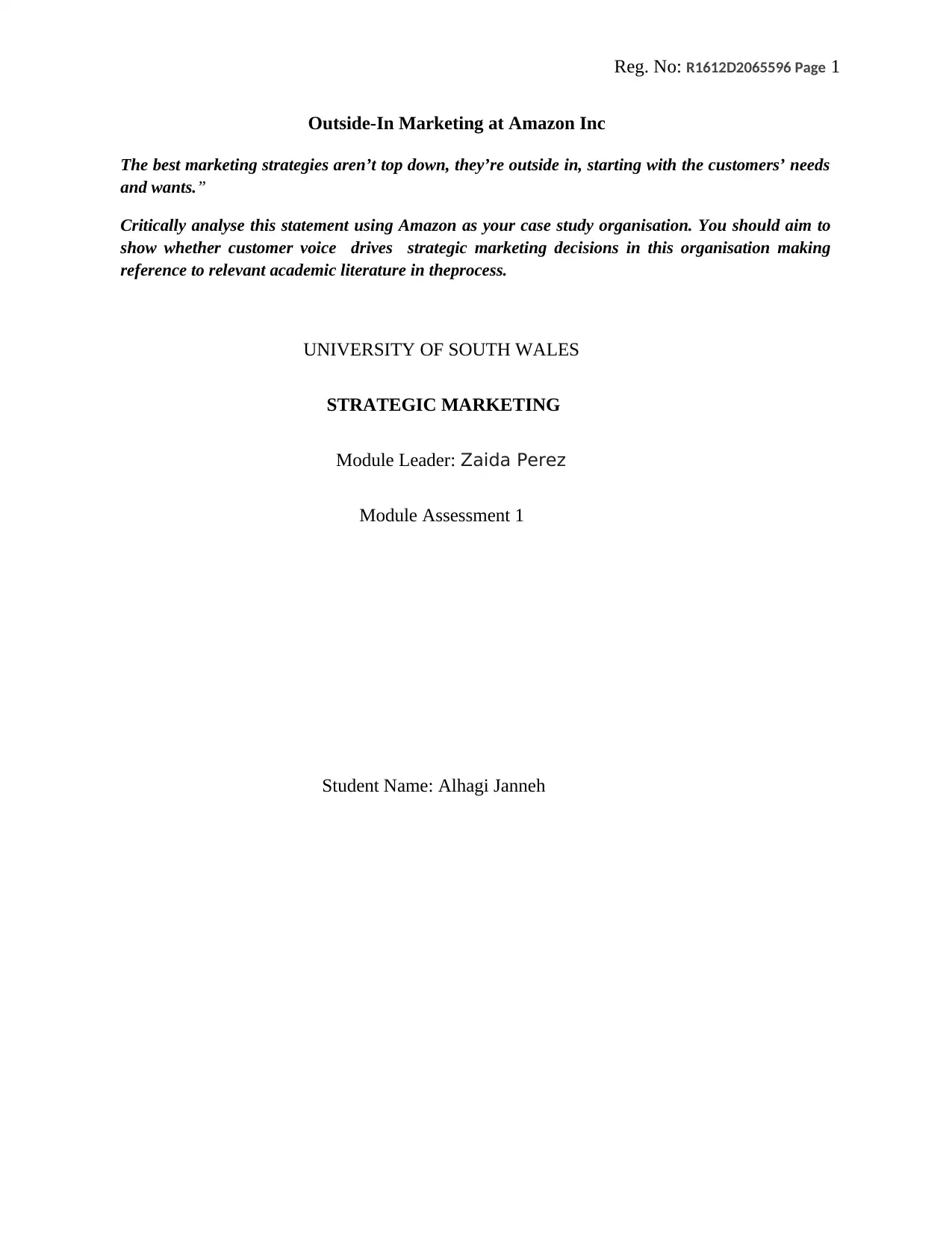
Reg. No: R1612D2065596 Page 1
Outside-In Marketing at Amazon Inc
The best marketing strategies aren’t top down, they’re outside in, starting with the customers’ needs
and wants.”
Critically analyse this statement using Amazon as your case study organisation. You should aim to
show whether customer voice drives strategic marketing decisions in this organisation making
reference to relevant academic literature in theprocess.
UNIVERSITY OF SOUTH WALES
STRATEGIC MARKETING
Module Leader: Zaida Perez
Module Assessment 1
Student Name: Alhagi Janneh
Outside-In Marketing at Amazon Inc
The best marketing strategies aren’t top down, they’re outside in, starting with the customers’ needs
and wants.”
Critically analyse this statement using Amazon as your case study organisation. You should aim to
show whether customer voice drives strategic marketing decisions in this organisation making
reference to relevant academic literature in theprocess.
UNIVERSITY OF SOUTH WALES
STRATEGIC MARKETING
Module Leader: Zaida Perez
Module Assessment 1
Student Name: Alhagi Janneh
Paraphrase This Document
Need a fresh take? Get an instant paraphrase of this document with our AI Paraphraser
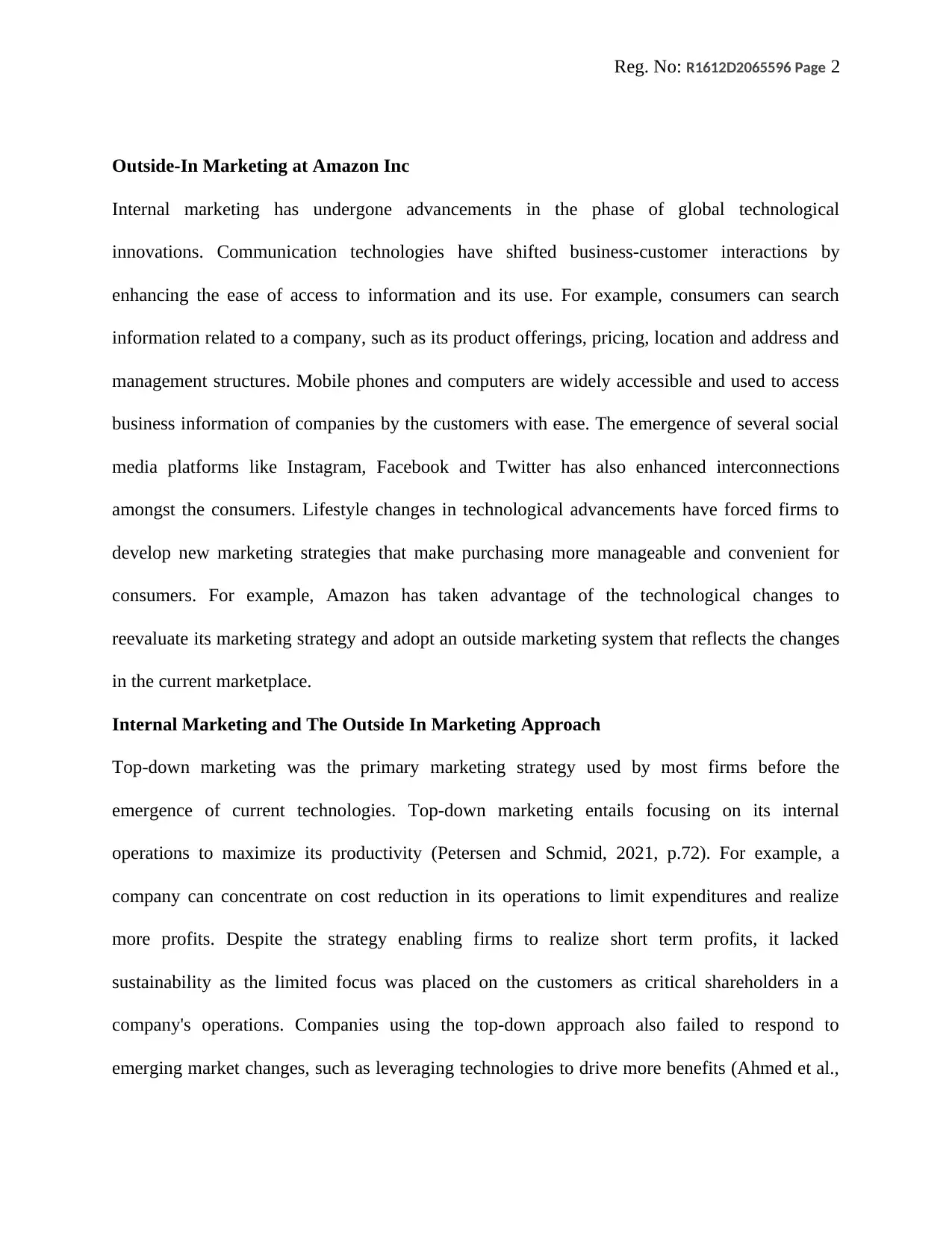
Reg. No: R1612D2065596 Page 2
Outside-In Marketing at Amazon Inc
Internal marketing has undergone advancements in the phase of global technological
innovations. Communication technologies have shifted business-customer interactions by
enhancing the ease of access to information and its use. For example, consumers can search
information related to a company, such as its product offerings, pricing, location and address and
management structures. Mobile phones and computers are widely accessible and used to access
business information of companies by the customers with ease. The emergence of several social
media platforms like Instagram, Facebook and Twitter has also enhanced interconnections
amongst the consumers. Lifestyle changes in technological advancements have forced firms to
develop new marketing strategies that make purchasing more manageable and convenient for
consumers. For example, Amazon has taken advantage of the technological changes to
reevaluate its marketing strategy and adopt an outside marketing system that reflects the changes
in the current marketplace.
Internal Marketing and The Outside In Marketing Approach
Top-down marketing was the primary marketing strategy used by most firms before the
emergence of current technologies. Top-down marketing entails focusing on its internal
operations to maximize its productivity (Petersen and Schmid, 2021, p.72). For example, a
company can concentrate on cost reduction in its operations to limit expenditures and realize
more profits. Despite the strategy enabling firms to realize short term profits, it lacked
sustainability as the limited focus was placed on the customers as critical shareholders in a
company's operations. Companies using the top-down approach also failed to respond to
emerging market changes, such as leveraging technologies to drive more benefits (Ahmed et al.,
Outside-In Marketing at Amazon Inc
Internal marketing has undergone advancements in the phase of global technological
innovations. Communication technologies have shifted business-customer interactions by
enhancing the ease of access to information and its use. For example, consumers can search
information related to a company, such as its product offerings, pricing, location and address and
management structures. Mobile phones and computers are widely accessible and used to access
business information of companies by the customers with ease. The emergence of several social
media platforms like Instagram, Facebook and Twitter has also enhanced interconnections
amongst the consumers. Lifestyle changes in technological advancements have forced firms to
develop new marketing strategies that make purchasing more manageable and convenient for
consumers. For example, Amazon has taken advantage of the technological changes to
reevaluate its marketing strategy and adopt an outside marketing system that reflects the changes
in the current marketplace.
Internal Marketing and The Outside In Marketing Approach
Top-down marketing was the primary marketing strategy used by most firms before the
emergence of current technologies. Top-down marketing entails focusing on its internal
operations to maximize its productivity (Petersen and Schmid, 2021, p.72). For example, a
company can concentrate on cost reduction in its operations to limit expenditures and realize
more profits. Despite the strategy enabling firms to realize short term profits, it lacked
sustainability as the limited focus was placed on the customers as critical shareholders in a
company's operations. Companies using the top-down approach also failed to respond to
emerging market changes, such as leveraging technologies to drive more benefits (Ahmed et al.,
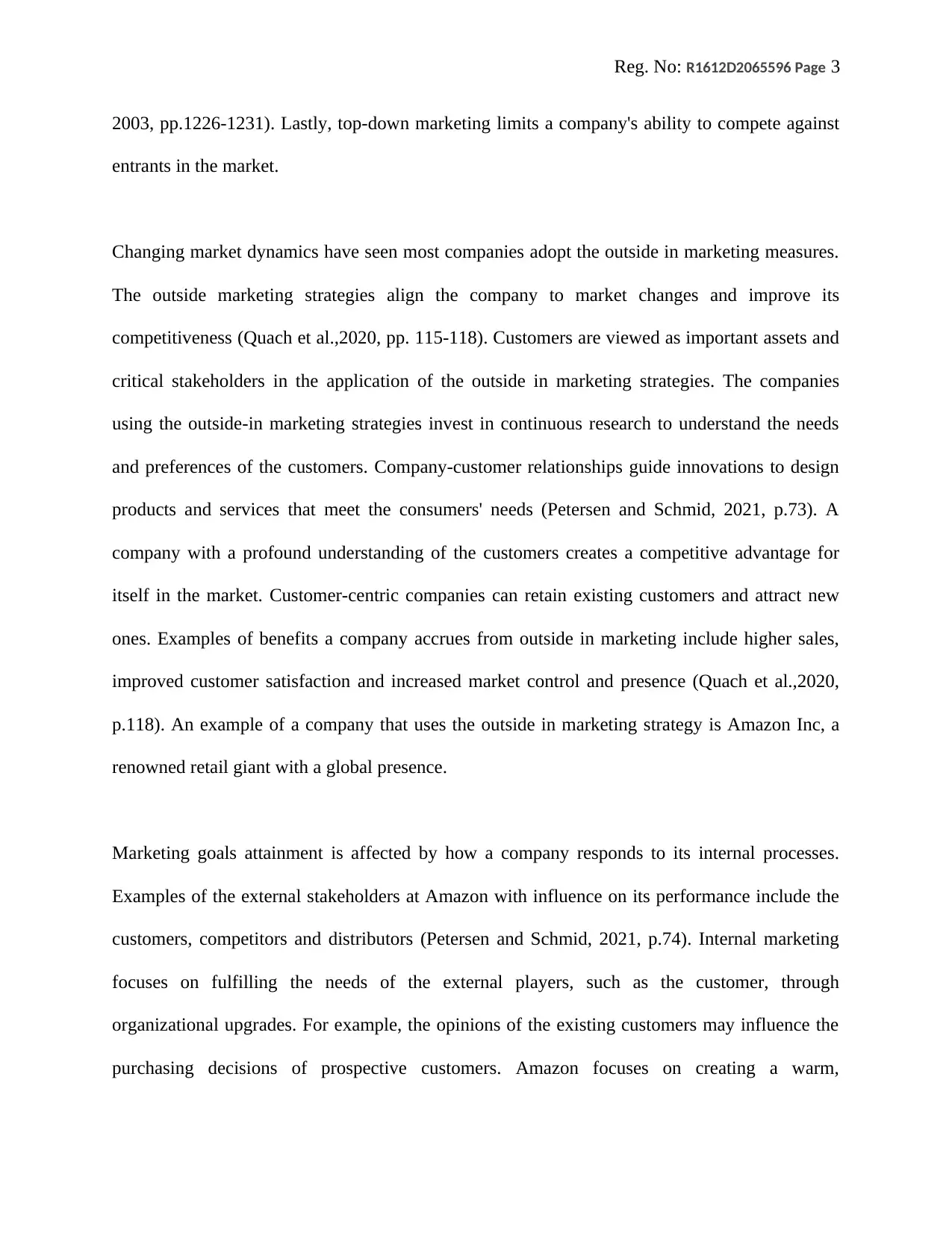
Reg. No: R1612D2065596 Page 3
2003, pp.1226-1231). Lastly, top-down marketing limits a company's ability to compete against
entrants in the market.
Changing market dynamics have seen most companies adopt the outside in marketing measures.
The outside marketing strategies align the company to market changes and improve its
competitiveness (Quach et al.,2020, pp. 115-118). Customers are viewed as important assets and
critical stakeholders in the application of the outside in marketing strategies. The companies
using the outside-in marketing strategies invest in continuous research to understand the needs
and preferences of the customers. Company-customer relationships guide innovations to design
products and services that meet the consumers' needs (Petersen and Schmid, 2021, p.73). A
company with a profound understanding of the customers creates a competitive advantage for
itself in the market. Customer-centric companies can retain existing customers and attract new
ones. Examples of benefits a company accrues from outside in marketing include higher sales,
improved customer satisfaction and increased market control and presence (Quach et al.,2020,
p.118). An example of a company that uses the outside in marketing strategy is Amazon Inc, a
renowned retail giant with a global presence.
Marketing goals attainment is affected by how a company responds to its internal processes.
Examples of the external stakeholders at Amazon with influence on its performance include the
customers, competitors and distributors (Petersen and Schmid, 2021, p.74). Internal marketing
focuses on fulfilling the needs of the external players, such as the customer, through
organizational upgrades. For example, the opinions of the existing customers may influence the
purchasing decisions of prospective customers. Amazon focuses on creating a warm,
2003, pp.1226-1231). Lastly, top-down marketing limits a company's ability to compete against
entrants in the market.
Changing market dynamics have seen most companies adopt the outside in marketing measures.
The outside marketing strategies align the company to market changes and improve its
competitiveness (Quach et al.,2020, pp. 115-118). Customers are viewed as important assets and
critical stakeholders in the application of the outside in marketing strategies. The companies
using the outside-in marketing strategies invest in continuous research to understand the needs
and preferences of the customers. Company-customer relationships guide innovations to design
products and services that meet the consumers' needs (Petersen and Schmid, 2021, p.73). A
company with a profound understanding of the customers creates a competitive advantage for
itself in the market. Customer-centric companies can retain existing customers and attract new
ones. Examples of benefits a company accrues from outside in marketing include higher sales,
improved customer satisfaction and increased market control and presence (Quach et al.,2020,
p.118). An example of a company that uses the outside in marketing strategy is Amazon Inc, a
renowned retail giant with a global presence.
Marketing goals attainment is affected by how a company responds to its internal processes.
Examples of the external stakeholders at Amazon with influence on its performance include the
customers, competitors and distributors (Petersen and Schmid, 2021, p.74). Internal marketing
focuses on fulfilling the needs of the external players, such as the customer, through
organizational upgrades. For example, the opinions of the existing customers may influence the
purchasing decisions of prospective customers. Amazon focuses on creating a warm,
⊘ This is a preview!⊘
Do you want full access?
Subscribe today to unlock all pages.

Trusted by 1+ million students worldwide
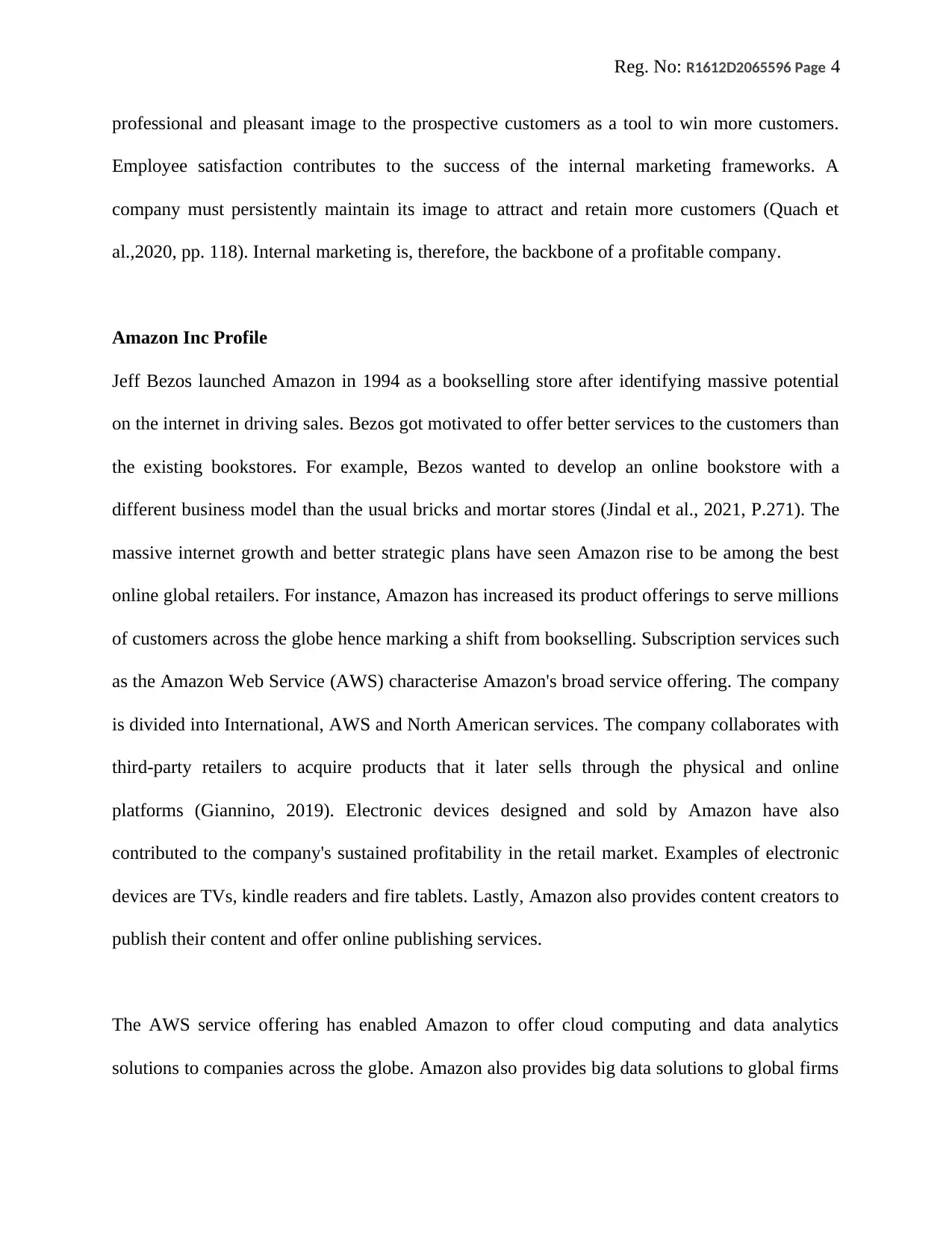
Reg. No: R1612D2065596 Page 4
professional and pleasant image to the prospective customers as a tool to win more customers.
Employee satisfaction contributes to the success of the internal marketing frameworks. A
company must persistently maintain its image to attract and retain more customers (Quach et
al.,2020, pp. 118). Internal marketing is, therefore, the backbone of a profitable company.
Amazon Inc Profile
Jeff Bezos launched Amazon in 1994 as a bookselling store after identifying massive potential
on the internet in driving sales. Bezos got motivated to offer better services to the customers than
the existing bookstores. For example, Bezos wanted to develop an online bookstore with a
different business model than the usual bricks and mortar stores (Jindal et al., 2021, P.271). The
massive internet growth and better strategic plans have seen Amazon rise to be among the best
online global retailers. For instance, Amazon has increased its product offerings to serve millions
of customers across the globe hence marking a shift from bookselling. Subscription services such
as the Amazon Web Service (AWS) characterise Amazon's broad service offering. The company
is divided into International, AWS and North American services. The company collaborates with
third-party retailers to acquire products that it later sells through the physical and online
platforms (Giannino, 2019). Electronic devices designed and sold by Amazon have also
contributed to the company's sustained profitability in the retail market. Examples of electronic
devices are TVs, kindle readers and fire tablets. Lastly, Amazon also provides content creators to
publish their content and offer online publishing services.
The AWS service offering has enabled Amazon to offer cloud computing and data analytics
solutions to companies across the globe. Amazon also provides big data solutions to global firms
professional and pleasant image to the prospective customers as a tool to win more customers.
Employee satisfaction contributes to the success of the internal marketing frameworks. A
company must persistently maintain its image to attract and retain more customers (Quach et
al.,2020, pp. 118). Internal marketing is, therefore, the backbone of a profitable company.
Amazon Inc Profile
Jeff Bezos launched Amazon in 1994 as a bookselling store after identifying massive potential
on the internet in driving sales. Bezos got motivated to offer better services to the customers than
the existing bookstores. For example, Bezos wanted to develop an online bookstore with a
different business model than the usual bricks and mortar stores (Jindal et al., 2021, P.271). The
massive internet growth and better strategic plans have seen Amazon rise to be among the best
online global retailers. For instance, Amazon has increased its product offerings to serve millions
of customers across the globe hence marking a shift from bookselling. Subscription services such
as the Amazon Web Service (AWS) characterise Amazon's broad service offering. The company
is divided into International, AWS and North American services. The company collaborates with
third-party retailers to acquire products that it later sells through the physical and online
platforms (Giannino, 2019). Electronic devices designed and sold by Amazon have also
contributed to the company's sustained profitability in the retail market. Examples of electronic
devices are TVs, kindle readers and fire tablets. Lastly, Amazon also provides content creators to
publish their content and offer online publishing services.
The AWS service offering has enabled Amazon to offer cloud computing and data analytics
solutions to companies across the globe. Amazon also provides big data solutions to global firms
Paraphrase This Document
Need a fresh take? Get an instant paraphrase of this document with our AI Paraphraser
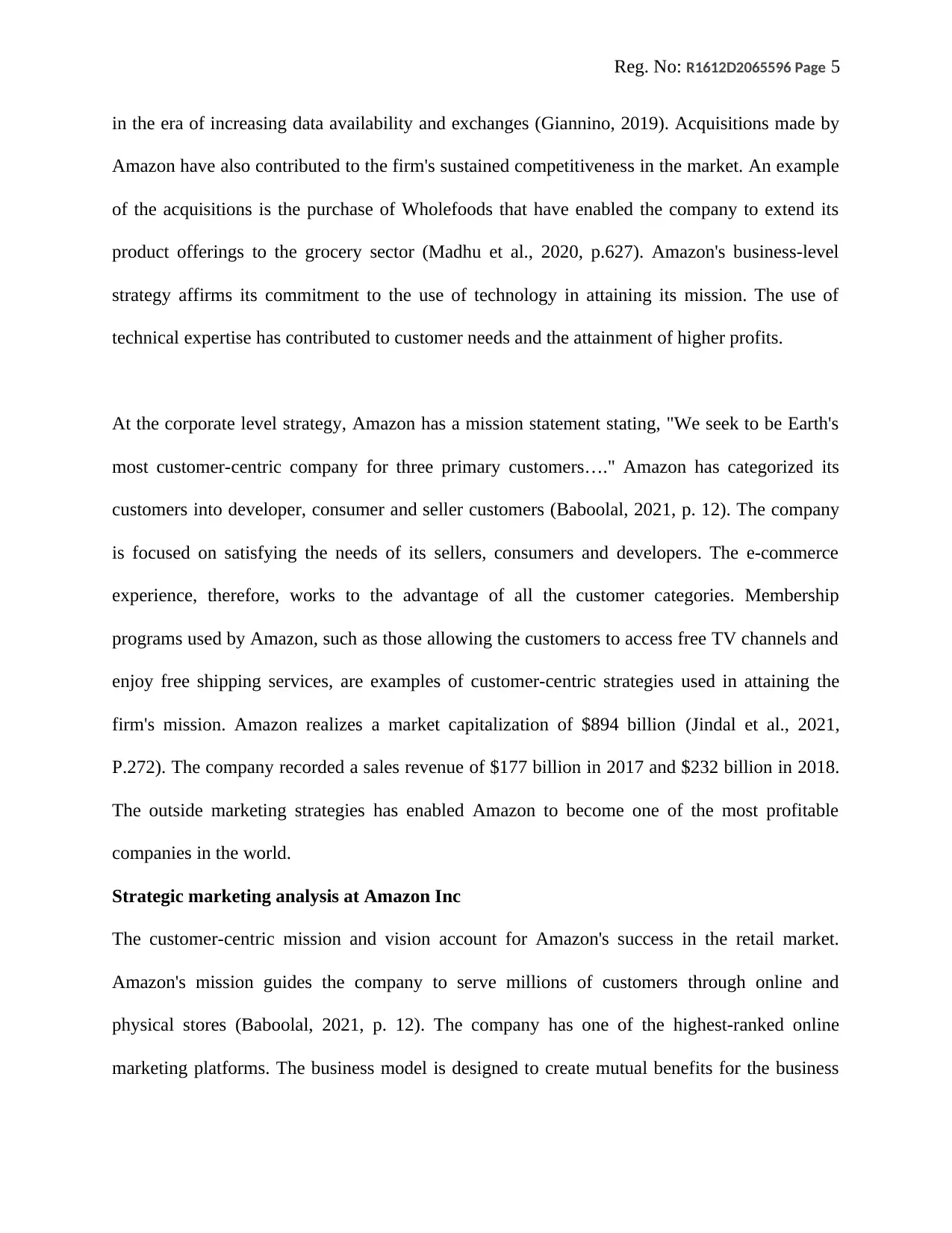
Reg. No: R1612D2065596 Page 5
in the era of increasing data availability and exchanges (Giannino, 2019). Acquisitions made by
Amazon have also contributed to the firm's sustained competitiveness in the market. An example
of the acquisitions is the purchase of Wholefoods that have enabled the company to extend its
product offerings to the grocery sector (Madhu et al., 2020, p.627). Amazon's business-level
strategy affirms its commitment to the use of technology in attaining its mission. The use of
technical expertise has contributed to customer needs and the attainment of higher profits.
At the corporate level strategy, Amazon has a mission statement stating, "We seek to be Earth's
most customer-centric company for three primary customers…." Amazon has categorized its
customers into developer, consumer and seller customers (Baboolal, 2021, p. 12). The company
is focused on satisfying the needs of its sellers, consumers and developers. The e-commerce
experience, therefore, works to the advantage of all the customer categories. Membership
programs used by Amazon, such as those allowing the customers to access free TV channels and
enjoy free shipping services, are examples of customer-centric strategies used in attaining the
firm's mission. Amazon realizes a market capitalization of $894 billion (Jindal et al., 2021,
P.272). The company recorded a sales revenue of $177 billion in 2017 and $232 billion in 2018.
The outside marketing strategies has enabled Amazon to become one of the most profitable
companies in the world.
Strategic marketing analysis at Amazon Inc
The customer-centric mission and vision account for Amazon's success in the retail market.
Amazon's mission guides the company to serve millions of customers through online and
physical stores (Baboolal, 2021, p. 12). The company has one of the highest-ranked online
marketing platforms. The business model is designed to create mutual benefits for the business
in the era of increasing data availability and exchanges (Giannino, 2019). Acquisitions made by
Amazon have also contributed to the firm's sustained competitiveness in the market. An example
of the acquisitions is the purchase of Wholefoods that have enabled the company to extend its
product offerings to the grocery sector (Madhu et al., 2020, p.627). Amazon's business-level
strategy affirms its commitment to the use of technology in attaining its mission. The use of
technical expertise has contributed to customer needs and the attainment of higher profits.
At the corporate level strategy, Amazon has a mission statement stating, "We seek to be Earth's
most customer-centric company for three primary customers…." Amazon has categorized its
customers into developer, consumer and seller customers (Baboolal, 2021, p. 12). The company
is focused on satisfying the needs of its sellers, consumers and developers. The e-commerce
experience, therefore, works to the advantage of all the customer categories. Membership
programs used by Amazon, such as those allowing the customers to access free TV channels and
enjoy free shipping services, are examples of customer-centric strategies used in attaining the
firm's mission. Amazon realizes a market capitalization of $894 billion (Jindal et al., 2021,
P.272). The company recorded a sales revenue of $177 billion in 2017 and $232 billion in 2018.
The outside marketing strategies has enabled Amazon to become one of the most profitable
companies in the world.
Strategic marketing analysis at Amazon Inc
The customer-centric mission and vision account for Amazon's success in the retail market.
Amazon's mission guides the company to serve millions of customers through online and
physical stores (Baboolal, 2021, p. 12). The company has one of the highest-ranked online
marketing platforms. The business model is designed to create mutual benefits for the business
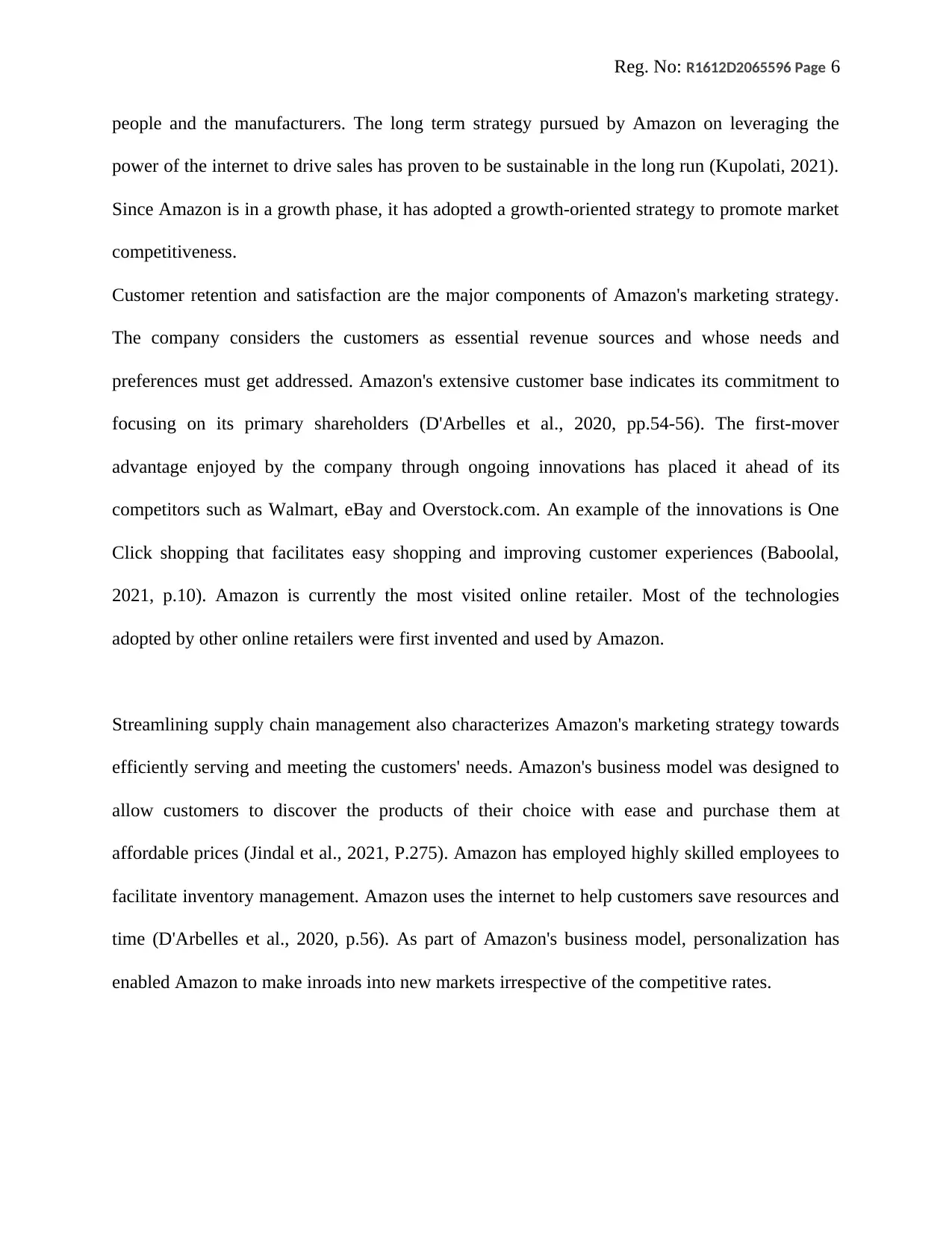
Reg. No: R1612D2065596 Page 6
people and the manufacturers. The long term strategy pursued by Amazon on leveraging the
power of the internet to drive sales has proven to be sustainable in the long run (Kupolati, 2021).
Since Amazon is in a growth phase, it has adopted a growth-oriented strategy to promote market
competitiveness.
Customer retention and satisfaction are the major components of Amazon's marketing strategy.
The company considers the customers as essential revenue sources and whose needs and
preferences must get addressed. Amazon's extensive customer base indicates its commitment to
focusing on its primary shareholders (D'Arbelles et al., 2020, pp.54-56). The first-mover
advantage enjoyed by the company through ongoing innovations has placed it ahead of its
competitors such as Walmart, eBay and Overstock.com. An example of the innovations is One
Click shopping that facilitates easy shopping and improving customer experiences (Baboolal,
2021, p.10). Amazon is currently the most visited online retailer. Most of the technologies
adopted by other online retailers were first invented and used by Amazon.
Streamlining supply chain management also characterizes Amazon's marketing strategy towards
efficiently serving and meeting the customers' needs. Amazon's business model was designed to
allow customers to discover the products of their choice with ease and purchase them at
affordable prices (Jindal et al., 2021, P.275). Amazon has employed highly skilled employees to
facilitate inventory management. Amazon uses the internet to help customers save resources and
time (D'Arbelles et al., 2020, p.56). As part of Amazon's business model, personalization has
enabled Amazon to make inroads into new markets irrespective of the competitive rates.
people and the manufacturers. The long term strategy pursued by Amazon on leveraging the
power of the internet to drive sales has proven to be sustainable in the long run (Kupolati, 2021).
Since Amazon is in a growth phase, it has adopted a growth-oriented strategy to promote market
competitiveness.
Customer retention and satisfaction are the major components of Amazon's marketing strategy.
The company considers the customers as essential revenue sources and whose needs and
preferences must get addressed. Amazon's extensive customer base indicates its commitment to
focusing on its primary shareholders (D'Arbelles et al., 2020, pp.54-56). The first-mover
advantage enjoyed by the company through ongoing innovations has placed it ahead of its
competitors such as Walmart, eBay and Overstock.com. An example of the innovations is One
Click shopping that facilitates easy shopping and improving customer experiences (Baboolal,
2021, p.10). Amazon is currently the most visited online retailer. Most of the technologies
adopted by other online retailers were first invented and used by Amazon.
Streamlining supply chain management also characterizes Amazon's marketing strategy towards
efficiently serving and meeting the customers' needs. Amazon's business model was designed to
allow customers to discover the products of their choice with ease and purchase them at
affordable prices (Jindal et al., 2021, P.275). Amazon has employed highly skilled employees to
facilitate inventory management. Amazon uses the internet to help customers save resources and
time (D'Arbelles et al., 2020, p.56). As part of Amazon's business model, personalization has
enabled Amazon to make inroads into new markets irrespective of the competitive rates.
⊘ This is a preview!⊘
Do you want full access?
Subscribe today to unlock all pages.

Trusted by 1+ million students worldwide
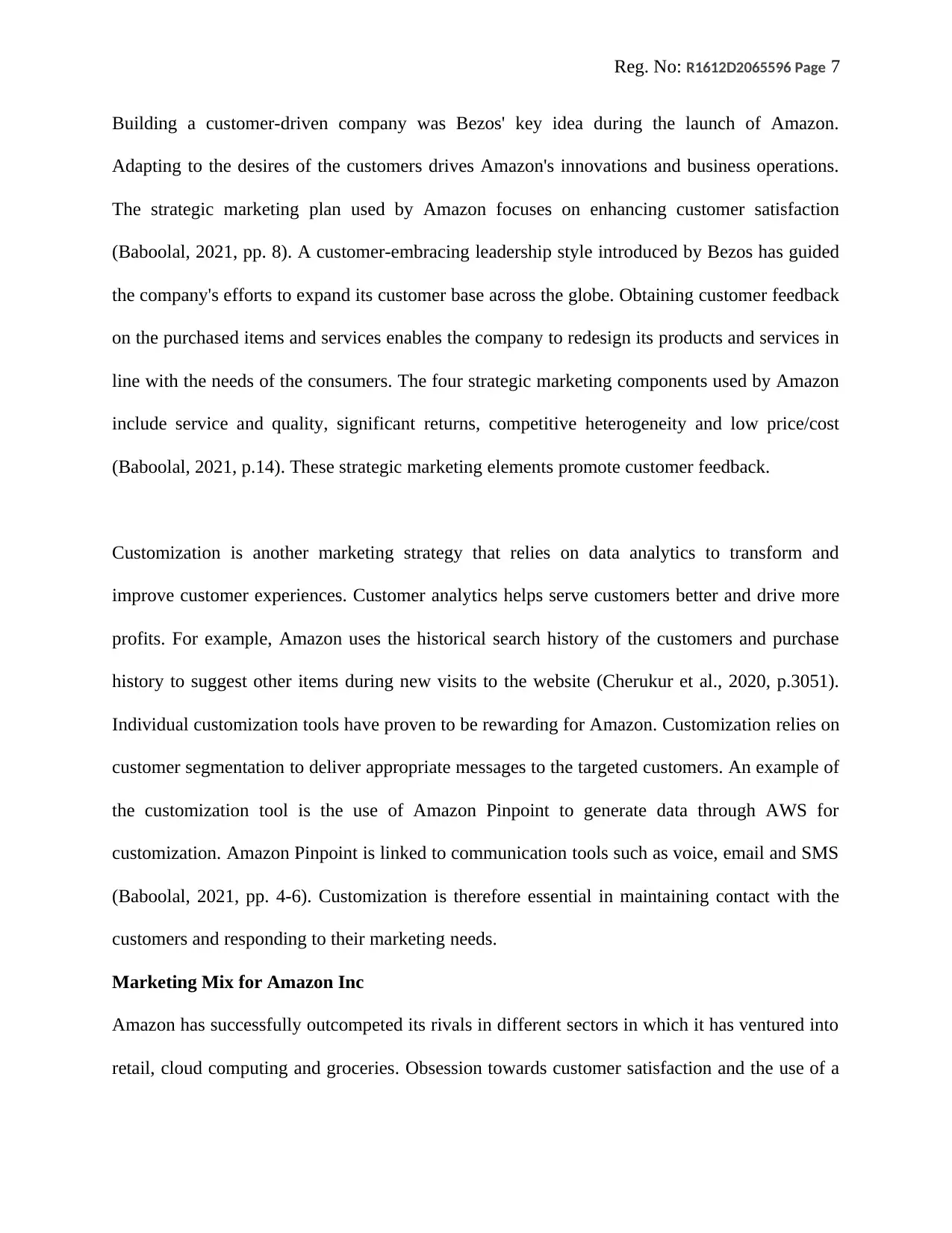
Reg. No: R1612D2065596 Page 7
Building a customer-driven company was Bezos' key idea during the launch of Amazon.
Adapting to the desires of the customers drives Amazon's innovations and business operations.
The strategic marketing plan used by Amazon focuses on enhancing customer satisfaction
(Baboolal, 2021, pp. 8). A customer-embracing leadership style introduced by Bezos has guided
the company's efforts to expand its customer base across the globe. Obtaining customer feedback
on the purchased items and services enables the company to redesign its products and services in
line with the needs of the consumers. The four strategic marketing components used by Amazon
include service and quality, significant returns, competitive heterogeneity and low price/cost
(Baboolal, 2021, p.14). These strategic marketing elements promote customer feedback.
Customization is another marketing strategy that relies on data analytics to transform and
improve customer experiences. Customer analytics helps serve customers better and drive more
profits. For example, Amazon uses the historical search history of the customers and purchase
history to suggest other items during new visits to the website (Cherukur et al., 2020, p.3051).
Individual customization tools have proven to be rewarding for Amazon. Customization relies on
customer segmentation to deliver appropriate messages to the targeted customers. An example of
the customization tool is the use of Amazon Pinpoint to generate data through AWS for
customization. Amazon Pinpoint is linked to communication tools such as voice, email and SMS
(Baboolal, 2021, pp. 4-6). Customization is therefore essential in maintaining contact with the
customers and responding to their marketing needs.
Marketing Mix for Amazon Inc
Amazon has successfully outcompeted its rivals in different sectors in which it has ventured into
retail, cloud computing and groceries. Obsession towards customer satisfaction and the use of a
Building a customer-driven company was Bezos' key idea during the launch of Amazon.
Adapting to the desires of the customers drives Amazon's innovations and business operations.
The strategic marketing plan used by Amazon focuses on enhancing customer satisfaction
(Baboolal, 2021, pp. 8). A customer-embracing leadership style introduced by Bezos has guided
the company's efforts to expand its customer base across the globe. Obtaining customer feedback
on the purchased items and services enables the company to redesign its products and services in
line with the needs of the consumers. The four strategic marketing components used by Amazon
include service and quality, significant returns, competitive heterogeneity and low price/cost
(Baboolal, 2021, p.14). These strategic marketing elements promote customer feedback.
Customization is another marketing strategy that relies on data analytics to transform and
improve customer experiences. Customer analytics helps serve customers better and drive more
profits. For example, Amazon uses the historical search history of the customers and purchase
history to suggest other items during new visits to the website (Cherukur et al., 2020, p.3051).
Individual customization tools have proven to be rewarding for Amazon. Customization relies on
customer segmentation to deliver appropriate messages to the targeted customers. An example of
the customization tool is the use of Amazon Pinpoint to generate data through AWS for
customization. Amazon Pinpoint is linked to communication tools such as voice, email and SMS
(Baboolal, 2021, pp. 4-6). Customization is therefore essential in maintaining contact with the
customers and responding to their marketing needs.
Marketing Mix for Amazon Inc
Amazon has successfully outcompeted its rivals in different sectors in which it has ventured into
retail, cloud computing and groceries. Obsession towards customer satisfaction and the use of a
Paraphrase This Document
Need a fresh take? Get an instant paraphrase of this document with our AI Paraphraser
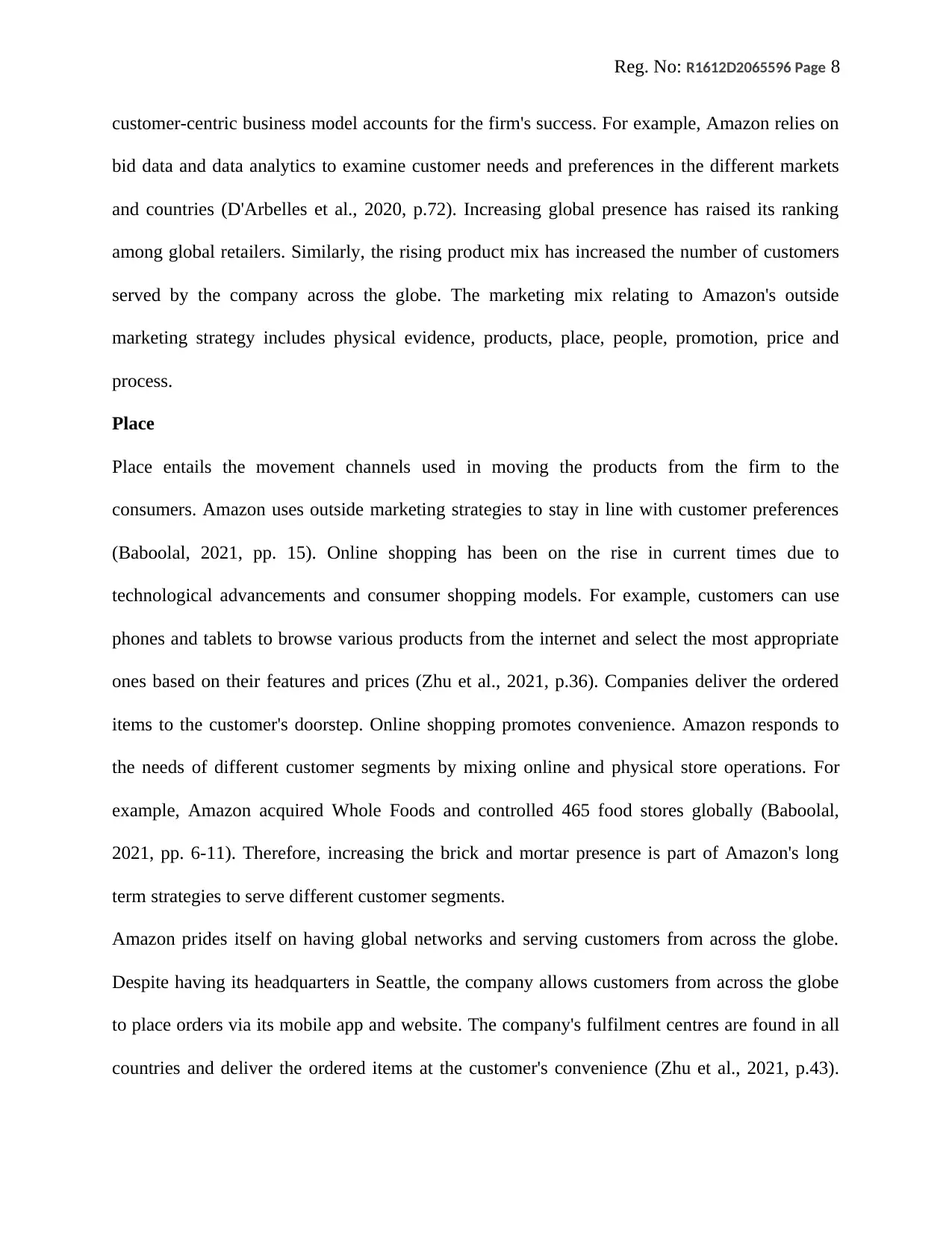
Reg. No: R1612D2065596 Page 8
customer-centric business model accounts for the firm's success. For example, Amazon relies on
bid data and data analytics to examine customer needs and preferences in the different markets
and countries (D'Arbelles et al., 2020, p.72). Increasing global presence has raised its ranking
among global retailers. Similarly, the rising product mix has increased the number of customers
served by the company across the globe. The marketing mix relating to Amazon's outside
marketing strategy includes physical evidence, products, place, people, promotion, price and
process.
Place
Place entails the movement channels used in moving the products from the firm to the
consumers. Amazon uses outside marketing strategies to stay in line with customer preferences
(Baboolal, 2021, pp. 15). Online shopping has been on the rise in current times due to
technological advancements and consumer shopping models. For example, customers can use
phones and tablets to browse various products from the internet and select the most appropriate
ones based on their features and prices (Zhu et al., 2021, p.36). Companies deliver the ordered
items to the customer's doorstep. Online shopping promotes convenience. Amazon responds to
the needs of different customer segments by mixing online and physical store operations. For
example, Amazon acquired Whole Foods and controlled 465 food stores globally (Baboolal,
2021, pp. 6-11). Therefore, increasing the brick and mortar presence is part of Amazon's long
term strategies to serve different customer segments.
Amazon prides itself on having global networks and serving customers from across the globe.
Despite having its headquarters in Seattle, the company allows customers from across the globe
to place orders via its mobile app and website. The company's fulfilment centres are found in all
countries and deliver the ordered items at the customer's convenience (Zhu et al., 2021, p.43).
customer-centric business model accounts for the firm's success. For example, Amazon relies on
bid data and data analytics to examine customer needs and preferences in the different markets
and countries (D'Arbelles et al., 2020, p.72). Increasing global presence has raised its ranking
among global retailers. Similarly, the rising product mix has increased the number of customers
served by the company across the globe. The marketing mix relating to Amazon's outside
marketing strategy includes physical evidence, products, place, people, promotion, price and
process.
Place
Place entails the movement channels used in moving the products from the firm to the
consumers. Amazon uses outside marketing strategies to stay in line with customer preferences
(Baboolal, 2021, pp. 15). Online shopping has been on the rise in current times due to
technological advancements and consumer shopping models. For example, customers can use
phones and tablets to browse various products from the internet and select the most appropriate
ones based on their features and prices (Zhu et al., 2021, p.36). Companies deliver the ordered
items to the customer's doorstep. Online shopping promotes convenience. Amazon responds to
the needs of different customer segments by mixing online and physical store operations. For
example, Amazon acquired Whole Foods and controlled 465 food stores globally (Baboolal,
2021, pp. 6-11). Therefore, increasing the brick and mortar presence is part of Amazon's long
term strategies to serve different customer segments.
Amazon prides itself on having global networks and serving customers from across the globe.
Despite having its headquarters in Seattle, the company allows customers from across the globe
to place orders via its mobile app and website. The company's fulfilment centres are found in all
countries and deliver the ordered items at the customer's convenience (Zhu et al., 2021, p.43).
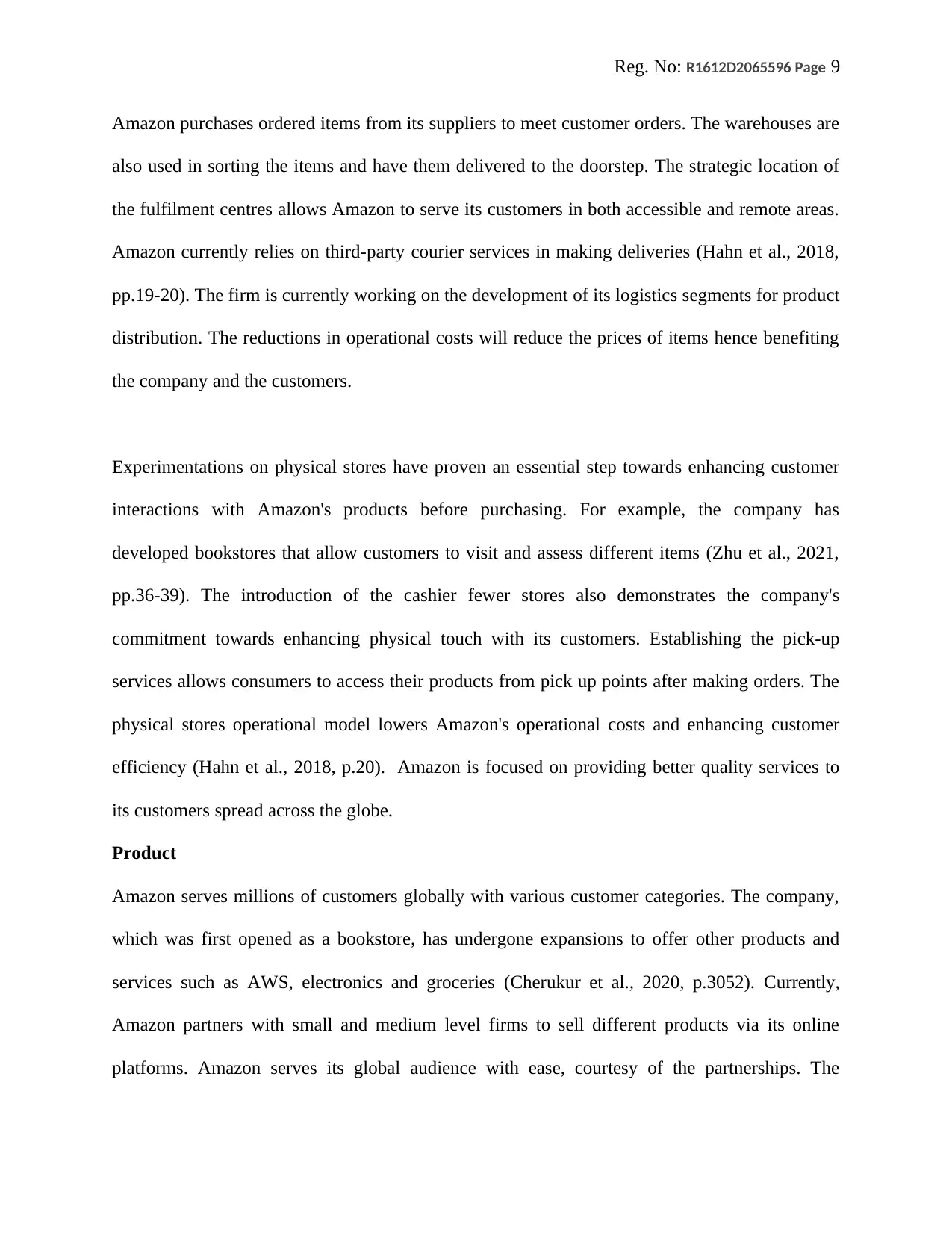
Reg. No: R1612D2065596 Page 9
Amazon purchases ordered items from its suppliers to meet customer orders. The warehouses are
also used in sorting the items and have them delivered to the doorstep. The strategic location of
the fulfilment centres allows Amazon to serve its customers in both accessible and remote areas.
Amazon currently relies on third-party courier services in making deliveries (Hahn et al., 2018,
pp.19-20). The firm is currently working on the development of its logistics segments for product
distribution. The reductions in operational costs will reduce the prices of items hence benefiting
the company and the customers.
Experimentations on physical stores have proven an essential step towards enhancing customer
interactions with Amazon's products before purchasing. For example, the company has
developed bookstores that allow customers to visit and assess different items (Zhu et al., 2021,
pp.36-39). The introduction of the cashier fewer stores also demonstrates the company's
commitment towards enhancing physical touch with its customers. Establishing the pick-up
services allows consumers to access their products from pick up points after making orders. The
physical stores operational model lowers Amazon's operational costs and enhancing customer
efficiency (Hahn et al., 2018, p.20). Amazon is focused on providing better quality services to
its customers spread across the globe.
Product
Amazon serves millions of customers globally with various customer categories. The company,
which was first opened as a bookstore, has undergone expansions to offer other products and
services such as AWS, electronics and groceries (Cherukur et al., 2020, p.3052). Currently,
Amazon partners with small and medium level firms to sell different products via its online
platforms. Amazon serves its global audience with ease, courtesy of the partnerships. The
Amazon purchases ordered items from its suppliers to meet customer orders. The warehouses are
also used in sorting the items and have them delivered to the doorstep. The strategic location of
the fulfilment centres allows Amazon to serve its customers in both accessible and remote areas.
Amazon currently relies on third-party courier services in making deliveries (Hahn et al., 2018,
pp.19-20). The firm is currently working on the development of its logistics segments for product
distribution. The reductions in operational costs will reduce the prices of items hence benefiting
the company and the customers.
Experimentations on physical stores have proven an essential step towards enhancing customer
interactions with Amazon's products before purchasing. For example, the company has
developed bookstores that allow customers to visit and assess different items (Zhu et al., 2021,
pp.36-39). The introduction of the cashier fewer stores also demonstrates the company's
commitment towards enhancing physical touch with its customers. Establishing the pick-up
services allows consumers to access their products from pick up points after making orders. The
physical stores operational model lowers Amazon's operational costs and enhancing customer
efficiency (Hahn et al., 2018, p.20). Amazon is focused on providing better quality services to
its customers spread across the globe.
Product
Amazon serves millions of customers globally with various customer categories. The company,
which was first opened as a bookstore, has undergone expansions to offer other products and
services such as AWS, electronics and groceries (Cherukur et al., 2020, p.3052). Currently,
Amazon partners with small and medium level firms to sell different products via its online
platforms. Amazon serves its global audience with ease, courtesy of the partnerships. The
⊘ This is a preview!⊘
Do you want full access?
Subscribe today to unlock all pages.

Trusted by 1+ million students worldwide
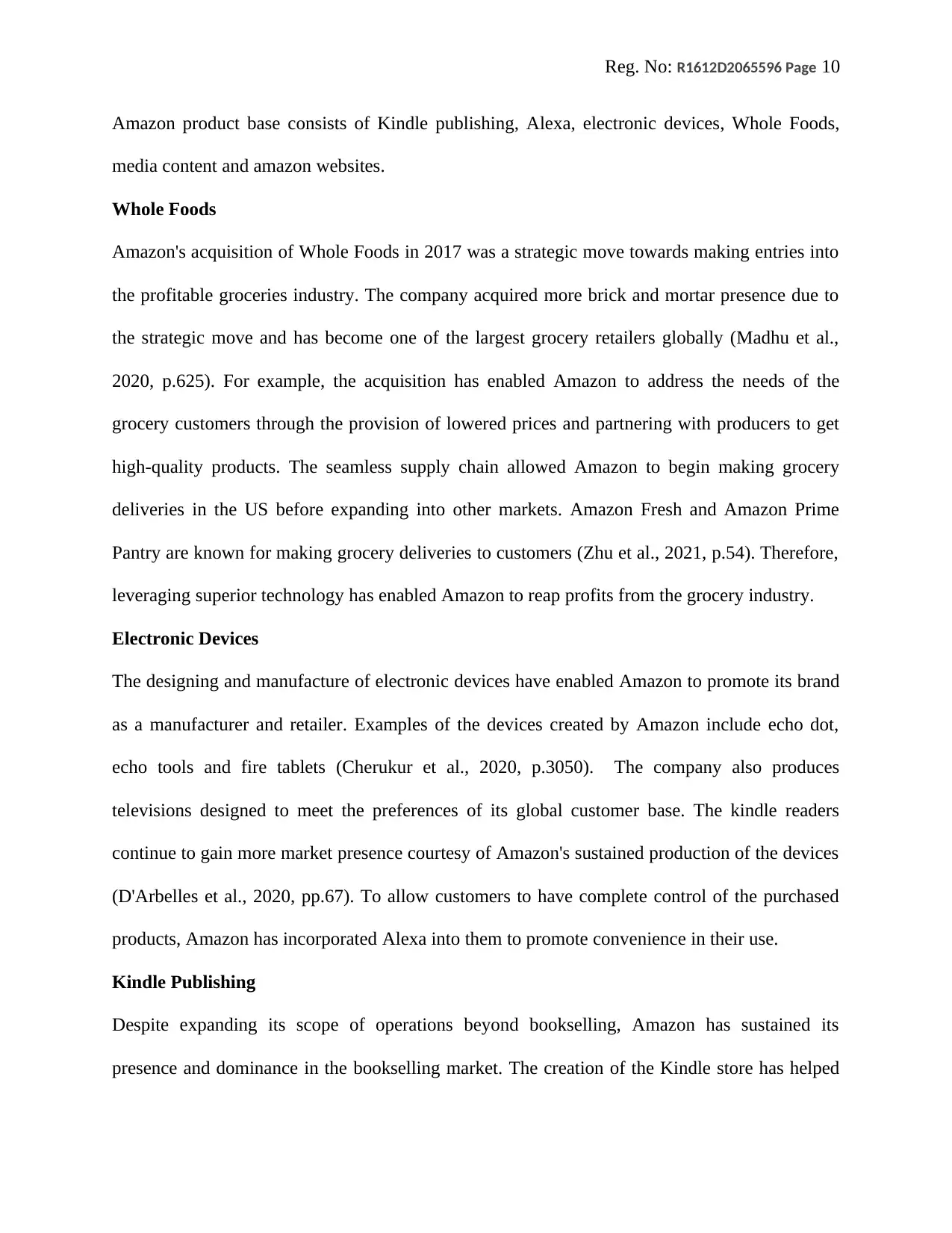
Reg. No: R1612D2065596 Page 10
Amazon product base consists of Kindle publishing, Alexa, electronic devices, Whole Foods,
media content and amazon websites.
Whole Foods
Amazon's acquisition of Whole Foods in 2017 was a strategic move towards making entries into
the profitable groceries industry. The company acquired more brick and mortar presence due to
the strategic move and has become one of the largest grocery retailers globally (Madhu et al.,
2020, p.625). For example, the acquisition has enabled Amazon to address the needs of the
grocery customers through the provision of lowered prices and partnering with producers to get
high-quality products. The seamless supply chain allowed Amazon to begin making grocery
deliveries in the US before expanding into other markets. Amazon Fresh and Amazon Prime
Pantry are known for making grocery deliveries to customers (Zhu et al., 2021, p.54). Therefore,
leveraging superior technology has enabled Amazon to reap profits from the grocery industry.
Electronic Devices
The designing and manufacture of electronic devices have enabled Amazon to promote its brand
as a manufacturer and retailer. Examples of the devices created by Amazon include echo dot,
echo tools and fire tablets (Cherukur et al., 2020, p.3050). The company also produces
televisions designed to meet the preferences of its global customer base. The kindle readers
continue to gain more market presence courtesy of Amazon's sustained production of the devices
(D'Arbelles et al., 2020, pp.67). To allow customers to have complete control of the purchased
products, Amazon has incorporated Alexa into them to promote convenience in their use.
Kindle Publishing
Despite expanding its scope of operations beyond bookselling, Amazon has sustained its
presence and dominance in the bookselling market. The creation of the Kindle store has helped
Amazon product base consists of Kindle publishing, Alexa, electronic devices, Whole Foods,
media content and amazon websites.
Whole Foods
Amazon's acquisition of Whole Foods in 2017 was a strategic move towards making entries into
the profitable groceries industry. The company acquired more brick and mortar presence due to
the strategic move and has become one of the largest grocery retailers globally (Madhu et al.,
2020, p.625). For example, the acquisition has enabled Amazon to address the needs of the
grocery customers through the provision of lowered prices and partnering with producers to get
high-quality products. The seamless supply chain allowed Amazon to begin making grocery
deliveries in the US before expanding into other markets. Amazon Fresh and Amazon Prime
Pantry are known for making grocery deliveries to customers (Zhu et al., 2021, p.54). Therefore,
leveraging superior technology has enabled Amazon to reap profits from the grocery industry.
Electronic Devices
The designing and manufacture of electronic devices have enabled Amazon to promote its brand
as a manufacturer and retailer. Examples of the devices created by Amazon include echo dot,
echo tools and fire tablets (Cherukur et al., 2020, p.3050). The company also produces
televisions designed to meet the preferences of its global customer base. The kindle readers
continue to gain more market presence courtesy of Amazon's sustained production of the devices
(D'Arbelles et al., 2020, pp.67). To allow customers to have complete control of the purchased
products, Amazon has incorporated Alexa into them to promote convenience in their use.
Kindle Publishing
Despite expanding its scope of operations beyond bookselling, Amazon has sustained its
presence and dominance in the bookselling market. The creation of the Kindle store has helped
Paraphrase This Document
Need a fresh take? Get an instant paraphrase of this document with our AI Paraphraser
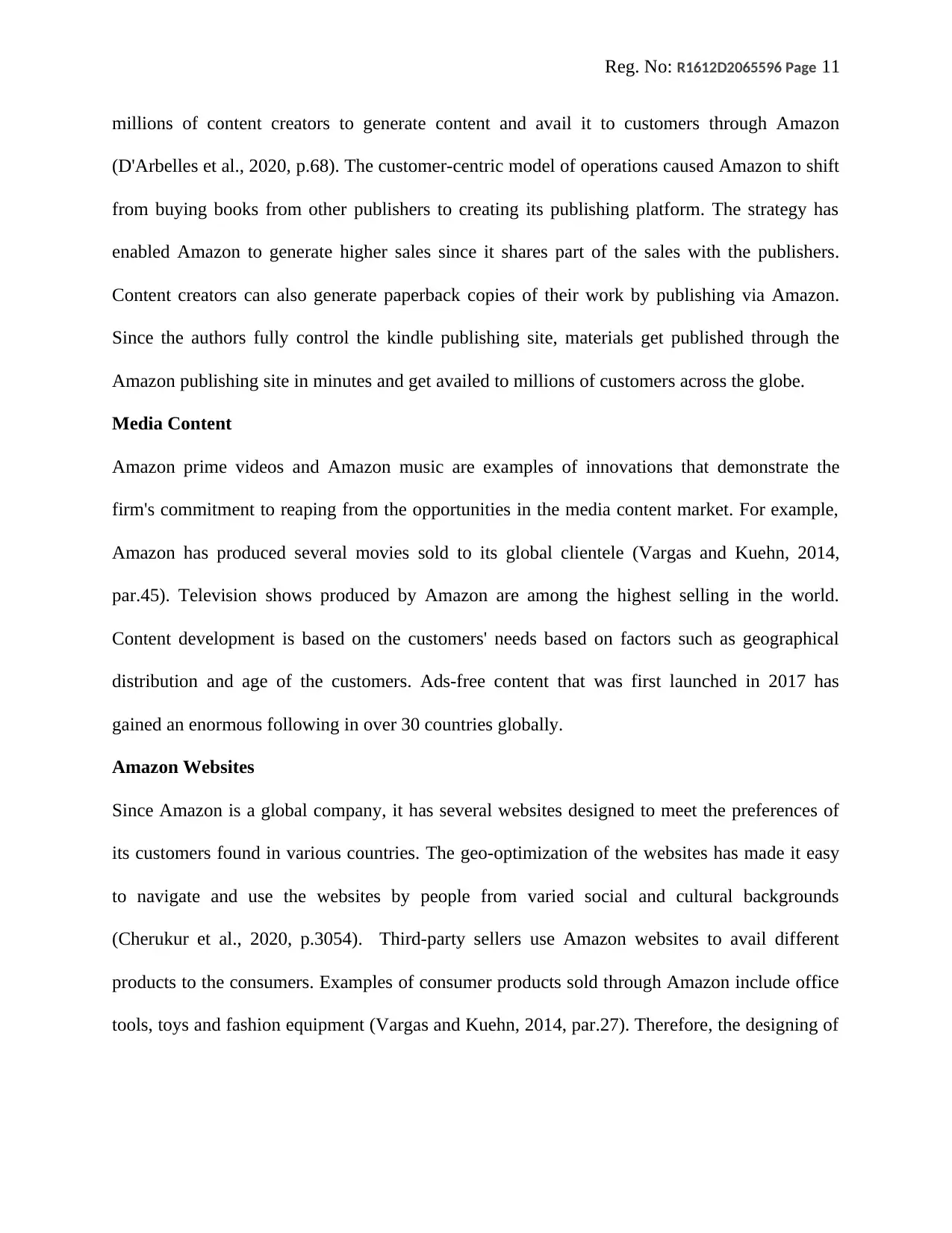
Reg. No: R1612D2065596 Page 11
millions of content creators to generate content and avail it to customers through Amazon
(D'Arbelles et al., 2020, p.68). The customer-centric model of operations caused Amazon to shift
from buying books from other publishers to creating its publishing platform. The strategy has
enabled Amazon to generate higher sales since it shares part of the sales with the publishers.
Content creators can also generate paperback copies of their work by publishing via Amazon.
Since the authors fully control the kindle publishing site, materials get published through the
Amazon publishing site in minutes and get availed to millions of customers across the globe.
Media Content
Amazon prime videos and Amazon music are examples of innovations that demonstrate the
firm's commitment to reaping from the opportunities in the media content market. For example,
Amazon has produced several movies sold to its global clientele (Vargas and Kuehn, 2014,
par.45). Television shows produced by Amazon are among the highest selling in the world.
Content development is based on the customers' needs based on factors such as geographical
distribution and age of the customers. Ads-free content that was first launched in 2017 has
gained an enormous following in over 30 countries globally.
Amazon Websites
Since Amazon is a global company, it has several websites designed to meet the preferences of
its customers found in various countries. The geo-optimization of the websites has made it easy
to navigate and use the websites by people from varied social and cultural backgrounds
(Cherukur et al., 2020, p.3054). Third-party sellers use Amazon websites to avail different
products to the consumers. Examples of consumer products sold through Amazon include office
tools, toys and fashion equipment (Vargas and Kuehn, 2014, par.27). Therefore, the designing of
millions of content creators to generate content and avail it to customers through Amazon
(D'Arbelles et al., 2020, p.68). The customer-centric model of operations caused Amazon to shift
from buying books from other publishers to creating its publishing platform. The strategy has
enabled Amazon to generate higher sales since it shares part of the sales with the publishers.
Content creators can also generate paperback copies of their work by publishing via Amazon.
Since the authors fully control the kindle publishing site, materials get published through the
Amazon publishing site in minutes and get availed to millions of customers across the globe.
Media Content
Amazon prime videos and Amazon music are examples of innovations that demonstrate the
firm's commitment to reaping from the opportunities in the media content market. For example,
Amazon has produced several movies sold to its global clientele (Vargas and Kuehn, 2014,
par.45). Television shows produced by Amazon are among the highest selling in the world.
Content development is based on the customers' needs based on factors such as geographical
distribution and age of the customers. Ads-free content that was first launched in 2017 has
gained an enormous following in over 30 countries globally.
Amazon Websites
Since Amazon is a global company, it has several websites designed to meet the preferences of
its customers found in various countries. The geo-optimization of the websites has made it easy
to navigate and use the websites by people from varied social and cultural backgrounds
(Cherukur et al., 2020, p.3054). Third-party sellers use Amazon websites to avail different
products to the consumers. Examples of consumer products sold through Amazon include office
tools, toys and fashion equipment (Vargas and Kuehn, 2014, par.27). Therefore, the designing of
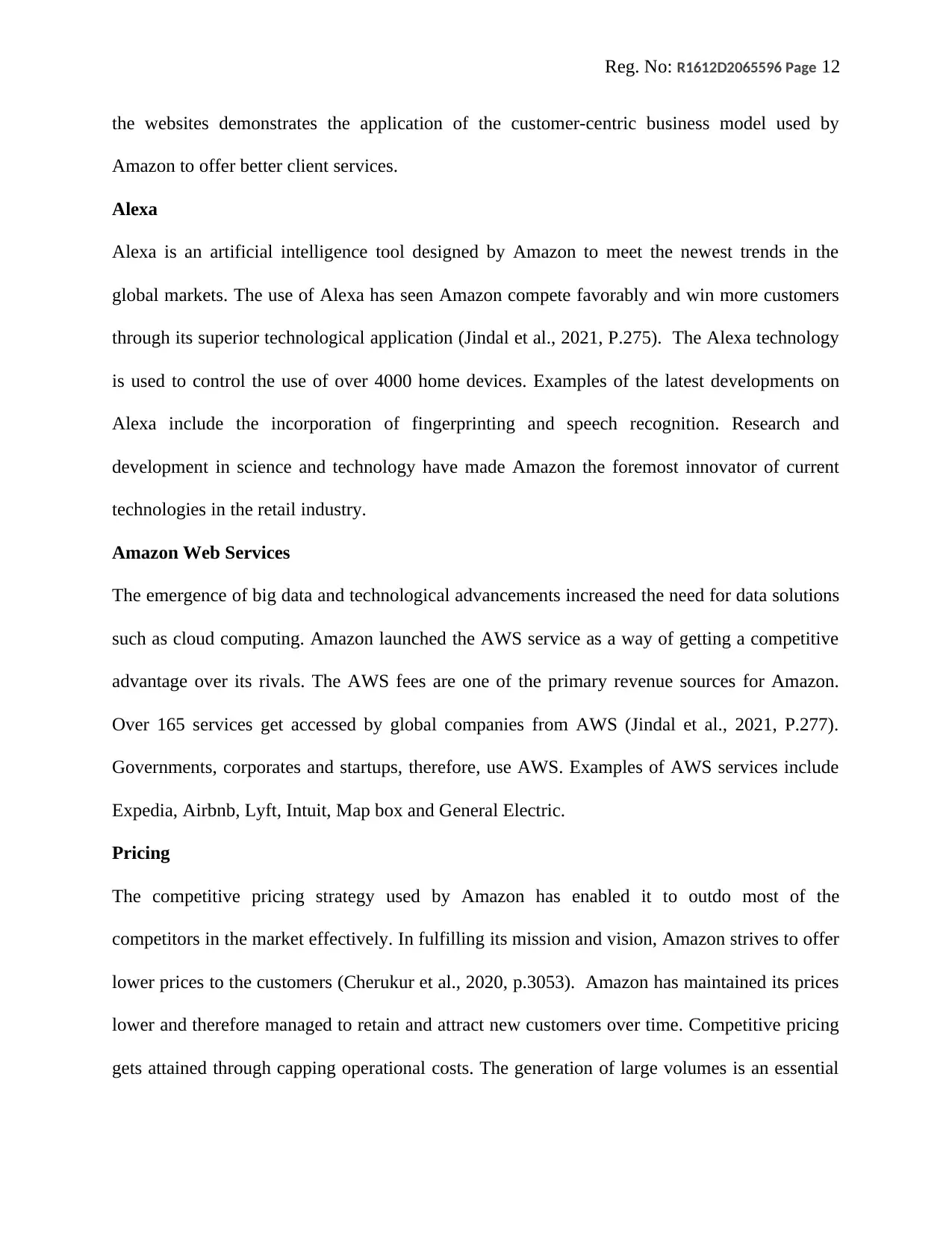
Reg. No: R1612D2065596 Page 12
the websites demonstrates the application of the customer-centric business model used by
Amazon to offer better client services.
Alexa
Alexa is an artificial intelligence tool designed by Amazon to meet the newest trends in the
global markets. The use of Alexa has seen Amazon compete favorably and win more customers
through its superior technological application (Jindal et al., 2021, P.275). The Alexa technology
is used to control the use of over 4000 home devices. Examples of the latest developments on
Alexa include the incorporation of fingerprinting and speech recognition. Research and
development in science and technology have made Amazon the foremost innovator of current
technologies in the retail industry.
Amazon Web Services
The emergence of big data and technological advancements increased the need for data solutions
such as cloud computing. Amazon launched the AWS service as a way of getting a competitive
advantage over its rivals. The AWS fees are one of the primary revenue sources for Amazon.
Over 165 services get accessed by global companies from AWS (Jindal et al., 2021, P.277).
Governments, corporates and startups, therefore, use AWS. Examples of AWS services include
Expedia, Airbnb, Lyft, Intuit, Map box and General Electric.
Pricing
The competitive pricing strategy used by Amazon has enabled it to outdo most of the
competitors in the market effectively. In fulfilling its mission and vision, Amazon strives to offer
lower prices to the customers (Cherukur et al., 2020, p.3053). Amazon has maintained its prices
lower and therefore managed to retain and attract new customers over time. Competitive pricing
gets attained through capping operational costs. The generation of large volumes is an essential
the websites demonstrates the application of the customer-centric business model used by
Amazon to offer better client services.
Alexa
Alexa is an artificial intelligence tool designed by Amazon to meet the newest trends in the
global markets. The use of Alexa has seen Amazon compete favorably and win more customers
through its superior technological application (Jindal et al., 2021, P.275). The Alexa technology
is used to control the use of over 4000 home devices. Examples of the latest developments on
Alexa include the incorporation of fingerprinting and speech recognition. Research and
development in science and technology have made Amazon the foremost innovator of current
technologies in the retail industry.
Amazon Web Services
The emergence of big data and technological advancements increased the need for data solutions
such as cloud computing. Amazon launched the AWS service as a way of getting a competitive
advantage over its rivals. The AWS fees are one of the primary revenue sources for Amazon.
Over 165 services get accessed by global companies from AWS (Jindal et al., 2021, P.277).
Governments, corporates and startups, therefore, use AWS. Examples of AWS services include
Expedia, Airbnb, Lyft, Intuit, Map box and General Electric.
Pricing
The competitive pricing strategy used by Amazon has enabled it to outdo most of the
competitors in the market effectively. In fulfilling its mission and vision, Amazon strives to offer
lower prices to the customers (Cherukur et al., 2020, p.3053). Amazon has maintained its prices
lower and therefore managed to retain and attract new customers over time. Competitive pricing
gets attained through capping operational costs. The generation of large volumes is an essential
⊘ This is a preview!⊘
Do you want full access?
Subscribe today to unlock all pages.

Trusted by 1+ million students worldwide
1 out of 22
Related Documents
Your All-in-One AI-Powered Toolkit for Academic Success.
+13062052269
info@desklib.com
Available 24*7 on WhatsApp / Email
![[object Object]](/_next/static/media/star-bottom.7253800d.svg)
Unlock your academic potential
Copyright © 2020–2025 A2Z Services. All Rights Reserved. Developed and managed by ZUCOL.





